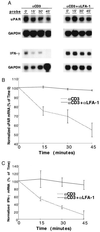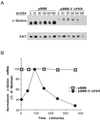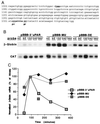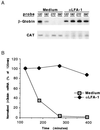Posttranscriptional regulation of urokinase plasminogen activator receptor messenger RNA levels by leukocyte integrin engagement
- PMID: 9600959
- PMCID: PMC27663
- DOI: 10.1073/pnas.95.11.6296
Posttranscriptional regulation of urokinase plasminogen activator receptor messenger RNA levels by leukocyte integrin engagement
Abstract
As an adhesion receptor, the beta2 integrin lymphocyte function-associated antigen-1 (LFA-1) contributes a strong adhesive force to promote T lymphocyte recirculation and interaction with antigen-presenting cells. As a signaling molecule, LFA-1-mediates transmembrane signaling, which leads to the generation of second messengers and costimulation resulting in T cell activation. We recently have demonstrated that, in costimulatory fashion, LFA-1 activation promotes the induction of T cell membrane urokinase plasminogen activator receptor (uPAR) and that this induced uPAR is functional. To investigate the mechanism(s) of this induction, we used the RNA polymerase II inhibitor 5, 6-dichloro-1-beta-D-ribobenzimidazole and determined that uPAR mRNA degradation is delayed by LFA-1 activation. Cloning of the wild-type, deleted and mutated 3'-untranslated region of the uPAR cDNA into a serum-inducible rabbit beta-globin cDNA reporter construct revealed that the AU-rich elements and, in particular the nonameric UUAUUUAUU sequence, are crucial cis-acting elements in uPAR mRNA degradation. Experiments in which Jurkat T cells were transfected with reporter constructs demonstrated that LFA-1 engagement was able to stabilize the unstable reporter mRNA containing the uPAR 3'-untranslated region. Our study reveals a consequence of adhesion receptor-mediated signaling in T cells, which is potentially important in the regulation of T cell activation, including production of cytokines and expression of proto-oncogenes, many of which are controlled through 3' AU-rich elements.
Figures





Similar articles
-
Structure, function and expression on blood and bone marrow cells of the urokinase-type plasminogen activator receptor, uPAR.Stem Cells. 1997;15(6):398-408. doi: 10.1002/stem.150398. Stem Cells. 1997. PMID: 9402652 Review.
-
Posttranscriptional regulation of urokinase receptor mRNA: identification of a novel urokinase receptor mRNA binding protein in human mesothelioma cells.Mol Cell Biol. 1997 Mar;17(3):1075-83. doi: 10.1128/MCB.17.3.1075. Mol Cell Biol. 1997. PMID: 9032234 Free PMC article.
-
Urokinase-type plasminogen activator up-regulates the expression of its cellular receptor through a post-transcriptional mechanism.FEBS Lett. 2001 Nov 23;508(3):379-84. doi: 10.1016/s0014-5793(01)03104-0. FEBS Lett. 2001. PMID: 11728456
-
Integrin-dependent induction of functional urokinase receptors in primary T lymphocytes.J Clin Invest. 1996 Sep 1;98(5):1133-41. doi: 10.1172/JCI118896. J Clin Invest. 1996. PMID: 8787676 Free PMC article.
-
Haemostatic factors occupy new territory: the role of the urokinase receptor system and kininogen in inflammation.Biochem Soc Trans. 2002 Apr;30(2):168-73. Biochem Soc Trans. 2002. PMID: 12023845 Review.
Cited by
-
Protein synthesis and urokinase mRNA metabolism.Mol Cell Biochem. 2005 Mar;271(1-2):13-22. doi: 10.1007/s11010-005-3453-x. Mol Cell Biochem. 2005. PMID: 15881651
-
Cell adhesion regulates gene expression at translational checkpoints in human myeloid leukocytes.Proc Natl Acad Sci U S A. 2001 Aug 28;98(18):10284-9. doi: 10.1073/pnas.181201398. Epub 2001 Aug 21. Proc Natl Acad Sci U S A. 2001. PMID: 11517314 Free PMC article.
-
Stabilization of urokinase and urokinase receptor mRNAs by HuR is linked to its cytoplasmic accumulation induced by activated mitogen-activated protein kinase-activated protein kinase 2.Mol Cell Biol. 2003 Oct;23(20):7177-88. doi: 10.1128/MCB.23.20.7177-7188.2003. Mol Cell Biol. 2003. PMID: 14517288 Free PMC article.
-
The RNA-binding zinc-finger protein tristetraprolin regulates AU-rich mRNAs involved in breast cancer-related processes.Oncogene. 2010 Jul 22;29(29):4205-15. doi: 10.1038/onc.2010.168. Epub 2010 May 24. Oncogene. 2010. PMID: 20498646 Free PMC article.
-
Regulation of urokinase receptor mRNA stability by hnRNP C in lung epithelial cells.Mol Cell Biochem. 2005 Apr;272(1-2):107-18. doi: 10.1007/s11010-005-7644-2. Mol Cell Biochem. 2005. PMID: 16010978
References
-
- Hynes R O. Cell. 1992;69:11–25. - PubMed
-
- Schwartz R H. Cell. 1992;71:1065–1068. - PubMed
-
- Fan S-T, Brian A A, Lollo B A, Mackman N, Shen N L, Edington T S. Cell Immunol. 1993;148:48–59. - PubMed
-
- Damle N K, Klussman K, Leytze G, Myrdal S, Aruffo A, Ledbetter J A, Linsley P S. J Immunol. 1994;152:2686– 2697. - PubMed
-
- Van Seventer G A, Shimizu Y, Horgan K J, Shaw S. J Immunol. 1990;144:4579–4586. - PubMed
Publication types
MeSH terms
Substances
Grants and funding
LinkOut - more resources
Full Text Sources
Other Literature Sources
Molecular Biology Databases
Research Materials

